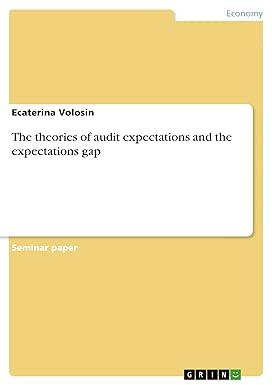Question
High-Tech Limited Case Study This case demonstrates the importance of strategy and cost allocation in the IT manufacturing environment. The case requires the development of
High-Tech Limited Case Study
This case demonstrates the importance of strategy and cost allocation in the IT manufacturing environment. The case requires the development of a relevant balanced scorecard for the business together with the construction of an appropriate ABC model.
Background
High-Tech (H-T) is a computer manufacturer founded in Yorkshire, England, in 1901. H-T originated as a commercial scale, cheese and meat slicing, punch card, tabulating and time recording conglomerate. The company began with 1300 employees and with sales in England, Scotland and Wales. The company had a difcult time managing its diversified products in numerous locations. H-T undertook several strategies to overcome its faltering operations. First, H-T increased sales by implementing healthy sales incentives, grooming its salesmen in dark suits, promoting company pride and loyalty in its employees and beefing up customer services. Second, H-T focused on selling tabulating machines, and expanded sales to the USA, Asia, Australia and South America. These strategies helped H-T overcome its sinking operations. While other companies were folding during the Great Depression, H-T continued to grow and began providing employee benefits such as life insurance and paid vacations. Just-in-time inventory control would not have been useful to H-T during the Depression. Because H-T had large inventories on hand, it was able to undertake large government contracts during the 1930s. H-T had become so large in the computer industry that it was constantly being sued, but unsuccessfully, for monopoly violations. During World War II, H-T continued to grow through government contracts. H-T used some of its profits to finance orphans and widows of war casualties. This goodwill act helped to foster employee loyalty and demonstrated good community citizenship. Technological development escalated beginning in the 1950s. H-T first developed a 5-ton 50-foot by 8-foot calculator. This calculator was replaced with vacuum tubes and later with a mainframe transistor that was faster and smaller than the vacuum tube. By 1957, H-T had a spinning disk storage system that could assess and process accounting data on as many as 50 disks and introduced the FORTRAN computer language. H-T was so large that it supplied 90% of Europes computers, had 80 billion in sales and 270 000 employees. Between 1970 and 1980, H-T became the leading manufacturer of mainframe computers, hardware, software and services. By the 1980s, H-T was manufacturing floppy disks, bank automatic teller machines, and PCs for small businesses, schools and home use. H-T now has manufacturing plants located in Yorkshire, England, and Essonnes, France. In Yorkshire, H-T manufactures low-end servers and personal computer systems while in Essonnes it manufactures logic and memory chips. H-T is now vertically integrated and produces, services and sells products exclusively in the computer industry. More recently, H-T has experienced a downturn in earnings resulting from a very competitive computer industry. Systems information H-Ts corporate strategy is to get multi-year cooperative agreements with SAP adopters to increase H-Ts share of the computer hardware market. H-T uses a normal costing system where manufacturing overhead is applied and estimated annually and quarterly and all other costs are recorded at actual using a stand-alone weighted-average accounting information and inventory system. Stand-alone implies that the cost accounting system is not integrated with financial accounting, finance or logistics ledgers. They hope to install SAP, an electronic resource planning system, but that has not happened yet. Because cost accounting is stand-alone, at the end of each quarter considerable accounting efort is spent integrating cost data with financial accounting and logistics data. Each production location (Yorkshire and Essonnes) is managed separately and within each location there is decentralisation of functions. The cost accountants focus solely on budgeting, recording and analysing costs (Exhibits 501.1 and 501.2). 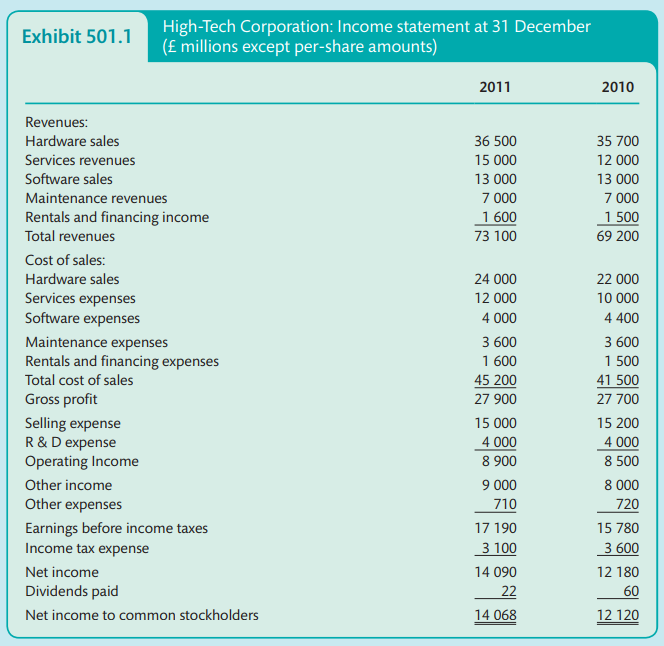
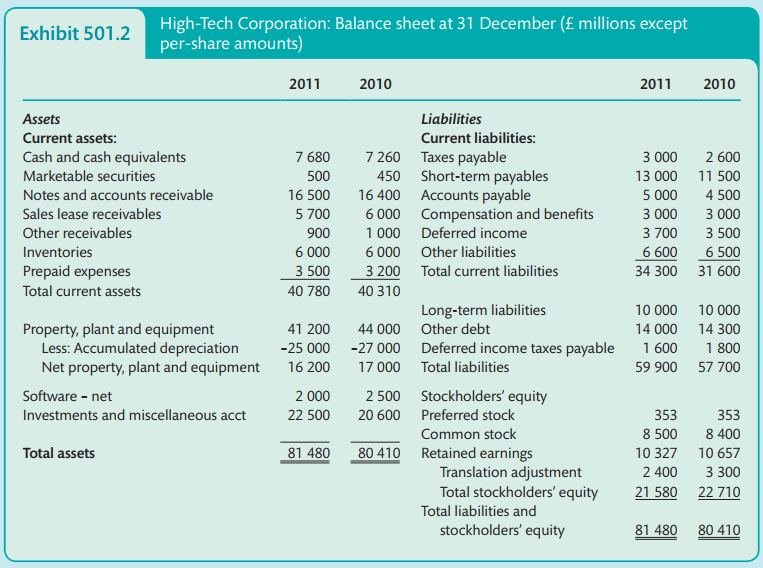
Yorkshire, England
The product development cycle for low-end servers and personal computer systems is three months. This means that faster and cheaper computers are developed at least three to four times a year. The computer industry experiences a 23% decline in raw material costs and selling prices each quarter. Therefore, product costs are changing constantly. While head count is high at Yorkshire, this cost is stable and represents only about 5% of product cost. Seventy per cent of product cost is materials and 25% is manufacturing overhead. Traditionally, for manufacturing overhead in production, direct labour s have been the allocation base. Yorkshire tries to trace most of its costs directly to the product. Labour and materials are traced directly to the product through bar codes. Each material input component is bar-coded and traced directly to the unit to which it is attached. As materials move through assembly, assemblers indicate which unit of output they are assembling through bar codes. For each product produced, a diskette includes the serial number assigned to the finished server, the assembler ID number and the identification number of parts used to make the server. Since the market fixes the price of labour and materials, H-T hopes to increase profit margins by reducing manufacturing overhead costs. H-T believes that it can reduce costs by reducing throughput time. Throughput is defined as follows:

H-Ts strongest competitors reduce throughput time by eliminating the dealer. Their competitors sell directly to the final or end customer. However, the dealers provide a level of immediate service to end customers at the end customers location that is not provided by its competitors. Competitors customers have to call an 0800 (freephone) number and sometimes wait 30 minutes on the phone before a technician can answer their question. Many customers who have software installation problems must see a computer specialist at their own cost, or for other problems they may have to return their equipment to the vendor and wait 23 weeks before the computer is replaced or repaired. Therefore, H-T must weigh the benefits of selling through dealers to its end customers against reducing throughput time by eliminating dealers. Lead time from dealer order to receipt of goods by the dealer is usually 34 weeks. Dealers generally hold five-week inventory levels to avoid stockout costs and to compensate for goods that may be damaged during shipment. If not sold immediately, dealers have unsold obsolete inventory on hand. In the past, H-T has provided rebates to dealers for obsolete inventory. This way, dealers can ofer obsolete inventory at discounted prices to their customers. H-T is concerned that this policy sends the wrong message to dealers. That is, if dealers do not move their inventory fast, the dealer does not lose because H-T will discount the merchandise. Therefore, dealers are not motivated to buy from H-T in small quantities or to sell their inventories quickly. H-T wants dealers to more accurately estimate their sales so that they do not end up with large quantities of obsolete inventory on hand. H-Ts competitors not only reduce dealer costs by not having dealers, but also reduce costs related to storing outdated inventory at the dealers location. H-T records procurement parts costs when invoiced. So if it invoices a purchase in March, it uses February costs because March costs are not known at the time of invoicing. At the end of March, when H-T knows the actual cost of March purchases, it records the under- or overapplied materials/parts cost as the diference between actual and recorded parts cost. Variances are investigated at the top end of the organisation, outside of the cost accounting department. Some variance is tolerated/expected due to the rapidly decreasing parts cost in the computer industry. Similarly, when dealers are billed for computers purchased, they are billed at the previous months price and the invoice price is adjusted the following month to reflect the actual selling price. That is, H-T does not know the cost of producing the computers and therefore the selling price of the computers until a month later when their vendors invoice raw materials. This is when H-T knows the actual cost of parts procurement. Sizing or the comparison of ledger to physical inventory is done annually. Shipment of almost all of H-Ts products (servers, PCs and mainframes) is out of Yorkshire. In addition to the production area, Yorkshire has 450 000 square feet of warehousing space. Inventory is in the warehouse for an average of 1015 days before shipping. H-T uses activity-based costing (ABC) to allocate annual warehousing and shipping costs to each product as follows (in millions): 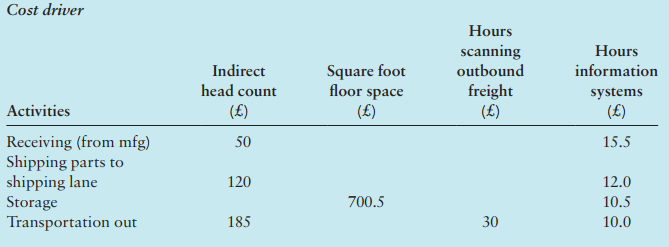
Annual allocation of expenses to products is then conducted as follows: 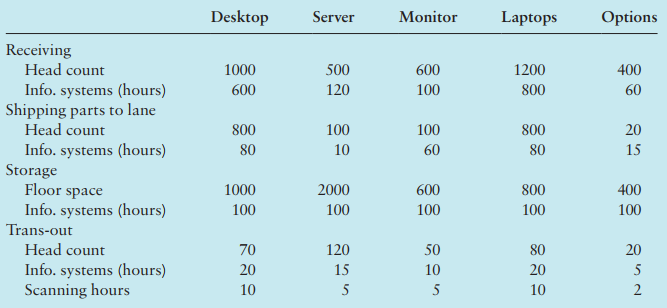
For some parts, transportation-out is the highest cost (servers). For example, servers have high transportation-out costs because they are heavy. For other products, order filling is the highest cost (desktops). For example, desktops absorb high order-filling costs because desktops are composed of multiple individual parts. The desktops may have 1015 pieces to a box so it takes more time to fill a desktop order than a server order, which is composed of one or two parts.
Essonnes, France
In Essonnes, France, H-T manufactures logic and memory chips from a silicon wafer. The silicon wafers are sliced from a silicon cylinder. The silicon cylinders are 400 each. Each working day H-T manufactures approximately 1200 wafers. In Essonnes, production takes place 24 hours a day, 7 days a week and 52 weeks a year. The only days of are 1 May because the French law of 1936 requires it and 25 December. However, accounting executives working hours are generally 8.30 a.m. to 6.00 p.m., five days a week. H-T purchases silicon cylinders for 400 each. Approximately 125 wafers can be sliced from each cylinder. During slicing, there is a loss of 20% of the silicon cylinder. It has quality assurance contracts with its vendors to assure the quality and on-time delivery of its production parts (silicon cylinders). After an order is received, H-T slices the silicon cylinders into wafers. From each wafer H-T can usually get a total of 100 logic chips and 400 memory chips of which 5% of the good output is loss. The loss is detected at the end of production. To minimise costs, H-T is currently focusing on increasing the yield from each cylinder and wafer. After end-of-line, the chips go to production control where they are distributed to their internal customers at a transfer price of 10% above total production cost. H-T spends considerable efort in developing and implementing its budget. H-T prepares five-year strategic plans from which flow yearly budgets and quarterly budgets. The annual budgets begin with actual data that is negotiated with production managers to produce annual and quarterly budgets. Budgeting involves a cross-functional team to ensure optimal corporate goal congruence (as opposed to unit-focused goals that may be suboptimal to the corporation as a whole). Senior management has weekly technical meetings with production regarding yield, lead time, and quality of shipped output. Each quarter (three months), H-T compares actual with monthly budgets. Usage of the service department centres during 2011 follows. 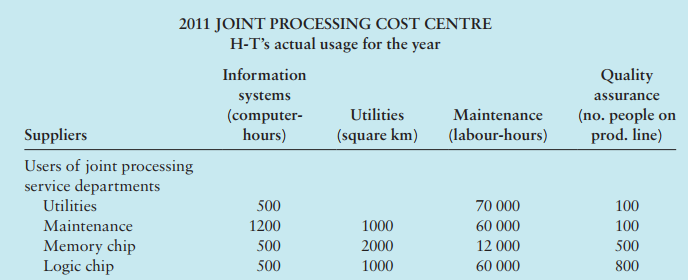
The budgeted charge-out rate for information systems is 10 000 per hour, for utilities is 20 000 per square kilometre, for maintenance is 80 per labour-hour and for quality assurance is 52 000 per person. Information systems include the salaries of personnel, accounting and budgeting costs and costs associated with the mainframe central processing unit. Utilities include building repairs, electricity, water, fuel, property taxes and building depreciation. Maintenance involves servicing the machinery used in production and computers and mainframe systems used throughout H-T. Quality assurance represents those personnel who measure quality and who conduct surveys on supplier, employee and customer satisfaction. Full absorption costing is used to determine product costs. (For the French definition of full absorption costing, see Bescos and Mendoza (1995).) H-T wants to assign costs so that managers maximise the quality of output and reduce the percentage of spoiled chips from each cylinder and wafer (yield). Currently H-T uses a traditional normal costing system and allocates all processing costs to the good chips only. H-T also wants a cost system that accurately allocates overhead costs to chips. To monitor quality, H-T continuously queries its suppliers, employees and customers. Employee satisfaction is important because it believes the more satisfied the employee, the more likely the employee will seek to achieve quality output efciently. In France, the employees are very concerned about job stability as a result of the downsizing that has taken place. H-T has reduced the number of buildings occupied by 60%, the number of employees by 40% and has increased production 100% over the past five years as a result of increased technology in its production facilities. Thus, employees are working harder to achieve corporate goals in a competitive environment. Customer surveys include questions about on-time delivery. H-T strives to have a 9899% on-time delivery rate.

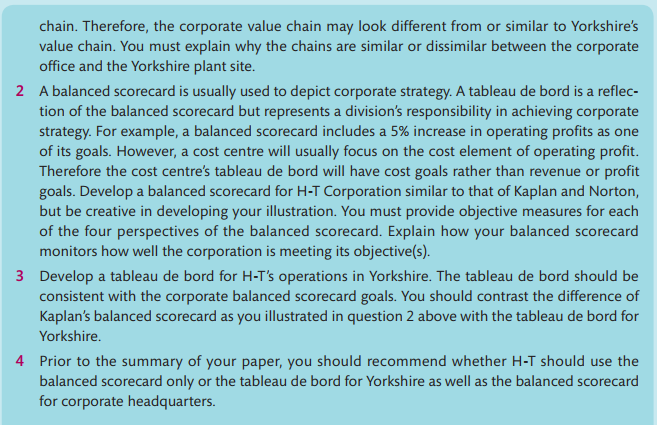

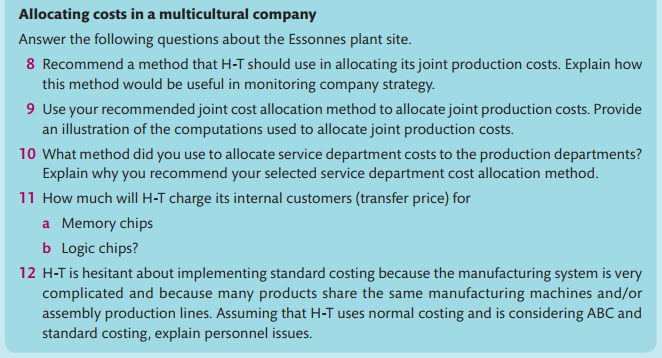
Step by Step Solution
There are 3 Steps involved in it
Step: 1

Get Instant Access to Expert-Tailored Solutions
See step-by-step solutions with expert insights and AI powered tools for academic success
Step: 2

Step: 3

Ace Your Homework with AI
Get the answers you need in no time with our AI-driven, step-by-step assistance
Get Started


